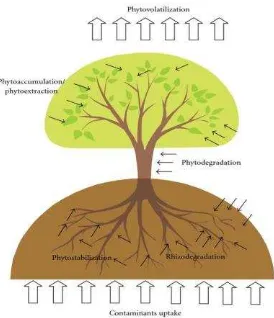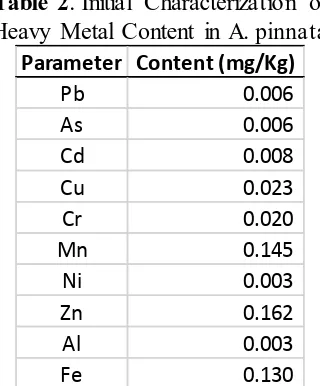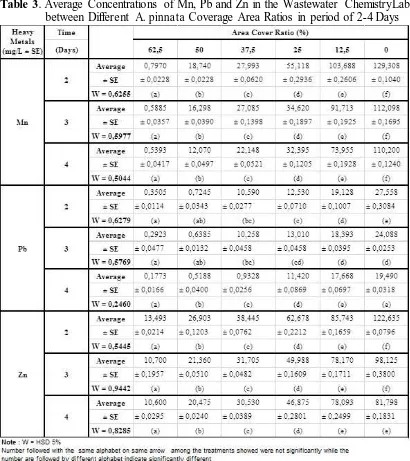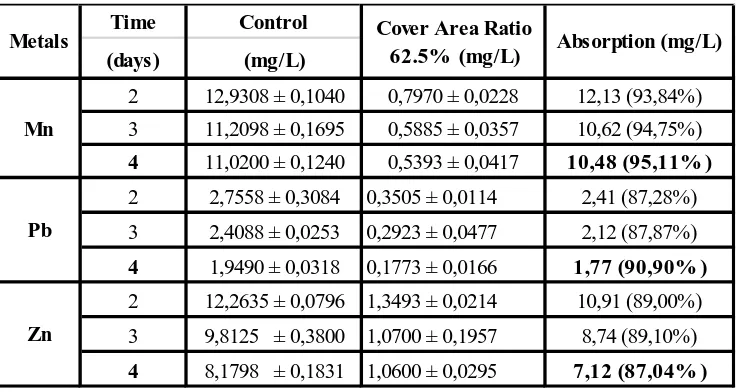Figure 1. Mechanism of phytoremediation (Tangahu et a l. 2011)
Some species of aquatic plants can be used as phytoremediation agents which are: floating aquatic fern (Salvinia molesta), water hyacinth (Eichhornia crassipes), water spinach (Ipomea aquatica), lesser duckweed (Lemna minor), and water fern (Azolla pinnata R.Br). Furthermore, A. pinnata has a total protein content reaches 25-35% (Basak et al., 2002, in Suryati, 2007), and the amino acid composition are as follows: lysine, methionine, cystine, threonine, tryptophan, arginine, isoleucine, leucine , phenyl, alanine, tyrosine, glycine, serine, and valine, respectively. Due to the high protein content, A. pinnata potentially has the ability to bind metal ions from the aqueous media (Alalade and Iyayi 2006, in Suryati, 2007).More over, Djojosuwito (2000, in Suryati 2007) explained how the water fern (A. pinnata) has the ability to absorb heavy metals which can be used to clean the water from heavy metals. According to Sachdeva and Sharma (2012), Azolla has the ability to absorb heavy metals such as chromium (Cr), zinc (Zn), nickel (Ni), Cadmium (Cd), copper (Cu), even Uranium (U). More over, Young and Weizhen (1985, in Sachdeva and Sharma, 2012) have studied four species of Azolla tolerance for Cu, Mn, Fe, Zn, Mo, Co, Cd, and other metals and found that Azolla spp. are able to survive in high concentrations of these metals, without affecting growth. Ganji et al. (2005, in Sachdeva and Sharma, 2012) found that A. pinnata and Lemna minor can remove heavy metals iron and copper from polluted water. The research of Thayapara et al. (2013) showed that A. pinnata is capable of absorbing lead (Pb) in amount of 1,383 mg / kg dry weight after four days of treatment and the concentration of lead (Pb) in the growth media has been reduced 83%. Results of other studies indicate that lead (Pb), cadmium (Cd), and copper (Cu) accumulate in the leaves of A. pinnata after 30-days period of growth, with the highest accumulation of Pb, Cd, and Cu, respectively, in amount of 270.11; 255.20; and 209.50 mg / m2 at a concentration of 2.0 ppm of each metal (Abd et al., 2011).
Based on the above mentioned matters, the purpose of this study are:
1. To determine the optimum of coverage area ratio of A. pinnata in the absorption of Mn, Zn, and Pb from Chemistry Laboratory wastewater.
[image:2.612.238.375.87.246.2]I. METHOD
Time and Place of the Study.
The study have been conducted in the Laboratory of Environmental Chemistry, Department of Chemistry, Faculty of Science and Mathematics (FSM), Satya Wacana Christian University (SWCU), Salatiga. The study started in August 2014 until May 2015.
Materials and Equipments
Materials. A. pinnata obtained from the rice fields located in Sidorejo Lor district , Salatiga. Wastewater was collected from liquid waste of Chemistry Laboratory, FSM-SWCU, Salatiga. The chemicals used were ferrous ammonium sulfate (FAS) 0.1 N, HgSO4, K2Cr2O7 0.25 N, AgSO4, MnSO4, Alkali-Iod solution, Na2S2O3 0.025 N, AlluVer 3 Alluminium Reagent, Chromaver 3 Reagent, Ferrover Iron Reagent.
Equipments. Spectrophotometer HACH DR / EL 2700, HACH DR / EL 2000, pH meter,
Balance analytical (Mettler H 80) at Laboratory of Enviromental Chemistry, FSM-SWCU, and the AAS (Atomic Absorption Spectroscopy) (Perkin Elmer, 3110) at Wahana Tata Laboratory, Semarang-Indonesia.
First of all, liquid wastewater of Chemistry Laboratory, FSM-SWCU was characterized on the physico-chemical characteristics, which were : temperature, color, turbidity, conductivity, TDS (Total Dissolved Solids), pH, alkalinity, COD (Chemical Oxygen Demand), Mn2+ , Pb2+, and Zn2+, respectively.
Laboratory waste treatment using A. pinnata. A. pinnata plants were grown in a plastic cup of 8.1 cm in diameter containing wastewater of Chemistry Laboratory. Each plastic cup filled with wastewater of Chemistry Laboratory with a concentration of 1.25%. The water ferns (A. pinnata) were grown with different coverage area ratios (%), its were as follow: 0%; 12.5%; 25%; 37.5%; 50%, and 62.5%, respectively, in the surface area of the plastic cup. The physico-chemical characteristics of wastewater were analyzed on the 2nd, 3rd, and 4th days, while the growth rate of A. pinnata were calculated on the 4th day and based by the wet and dry weight (Hunt (1978) in Leblebici et al., 2009).
Analysis of heavy metals in wastewater were measured using a spectrophotometer HACH
DR / EL 2700 Chemistry Laboratory, Department of Chemistry, FSM-SWCU, Salatiga and Atomic Absorption Spectroscopy (Perkin Elmer, 3110) at the Wahana Tata Laboratory- Semarang.
Data Analysis (Steel & Torie, 1980). Data sorption of heavy metals Mn, Zn and Pb were
RESULTS AND DISCUSSION
Initial Characterization of Wastewater Chemistry Laboratory and A. pinnata.
The results of the initial characterization of wastewater Chemistry Laboratory and A. pinnata are presented in Table 1 and Table 2.
Table 1. Initial Characterization of Chemistry Laboratory Wastewater as Growing Media
Parameter Content
Physical
Temperature (oC) 26
TDS (ppm) 8,300
Electrical Conductivity (µS/cm) 16,600 Color (PtCo) 3,000 Turbidity (FTU) 1,000 Chemical
pH 2.1
COD (ppm) 60,000
Pb (ppm) 6.135
As (ppm) 2.319
Hg (ppm) 0.265
Cd (ppm) 4.340
Cu (ppm) 3.890
Cr (ppm) 3.620
Mn (ppm) 8.148
Ni (ppm) 0.937
Zn (ppm) 18.240
Al (ppm) 2.150
Fe (ppm) 11.235
Table 1 showed that the heavy metals concentration in Chemistry Laboratory were Mn:
[image:4.612.235.395.515.708.2]8.148 ppm; Pb : 6.135 ppm; and Zn: 18.240 ppm, respectively. While the initial measurement of the heavy metals content in A. pinnata were presented in Table 2.
Table 2. Initial Characterization of
Heavy Metal Content in A. pinnata Parameter Content (mg/Kg)
Note : The water content of A. pinna ta was 94.19%
From Table 2 it showed that A. pinnata contained different levels of heavy metals, ranging from 0.006 mg/kg to 0.162 mg/kg.
Table 3. Average Concentrations of Mn, Pb and Zn in the Wastewater ChemistryLaboratory
between Different A. pinnata Coverage Area Ratios in period of 2-4 Days
The mean concentrations of Zn (mg/L ± SE) between different coverage areas ratio of A. pinnata in period of 2-4 days ranged between 1.0600 ± 0.0295 mg / L to 12.2635 ± 0.0796 mg / L. The highest Zn concentrations absorbed by A. pinnata from the wastewater Chemistry Laboratory within 2-4 days occurred in 62.5% A. pinnata coverage ratio with the absorption effectiveness of 8.74 mg / L (89.10%) on the 3rd days.
[image:7.612.79.448.321.517.2]Table 4 showed that A. pinnata area cover ratio of 62.5% is the best area cover ratio for the absorption of Mn, especially on day 4 with the effectiveness of Mn absorption of 95.11%. Effectiveness of Mn uptake by A. pinnata ranged from 10.48 mg/L (day 4) up to 12.13 mg/L (day 2). On the 2nd day effectiveness Mn uptake by A. pinnata high that is 12.13 mg/L (93.84%), it is associated with Mn which is one of the nutrients required by A. pinnata for growth.
Table 4. Effectiveness Absorption of Metal Zn, Pb and Zn by A. pinna ta on Waste Water Chemistry Laboratory in The Cover Area Ratio of 62.5% During 2-4 Days
Time Control
(days) (mg/L)
2 12,9308 ± 0,1040 0,7970 ± 0,0228 12,13 (93,84%)
3 11,2098 ± 0,1695 0,5885 ± 0,0357 10,62 (94,75%) 4 11,0200 ± 0,1240 0,5393 ± 0,0417 10,48 (95,11% ) 2 2,7558 ± 0,3084 0,3505 ± 0,0114 2,41 (87,28%)
3 2,4088 ± 0,0253 0,2923 ± 0,0477 2,12 (87,87%)
4 1,9490 ± 0,0318 0,1773 ± 0,0166 1,77 (90,90% ) 2 12,2635 ± 0,0796 1,3493 ± 0,0214 10,91 (89,00%)
3 9,8125 ± 0,3800 1,0700 ± 0,1957 8,74 (89,10%)
4 8,1798 ± 0,1831 1,0600 ± 0,0295 7,12 (87,04% ) Zn
Metals Cover Area Ratio
62.5% (mg/L) Absorption (mg/L)
Mn
Pb
Effectiveness of the optimum absorption of Pb by A. pinnata occured in the coverage area ratio of 62.5% in amount of 1.77 mg/L (90.90%) on the 4th day. Toxicity effect of heavy metals on plant growth follows the order as follows: Cu> Se> Pb> Cd> Ni> Cr (Zayed, 1998, in Chaudhary and Sharma, 2014). In the point of viewed from the toxicity effect, A. pinnata is able to absorb lead (Pb) in conjunction with the absorption of Zn and Mn. In addition, the pH effect on the absorption of heavy metals is more acidic in the higher solubility of heavy metals, making it easily absorbed.
According Suprihatin and Indrasti (2010) metal solubility decreased with increasing pH. Furthermore, according to Noor (1994, in Yuniarti, 2012) describes the absorption of heavy metals by plants is influenced by a competitor, metal, natural ligands, and artificial, characteristics and type of environment, plants, and the pH of the solution. The results of Sanyahumbi et al. (1998, in Bennicelli et al., 2004) showed that the absorption of Pb by A. filiculoides L. affected by pH and the pH value of 3.5 and 4.5 is an optimal pH in the absorption
of Pb. More over Hidayat (2011) showed that A. pinnata is able to absorb Pb in the amount to 4.68% from Pb concentration of 140 ppm.
Murdhiani (2011) indicates that Azolla is able to decrease the concentration of lead (Pb) to 100% in a rice field irrigation system. Furthermore, another study by Thayapara et al. (2013) showed that A. pinnata is capable of absorbing lead (Pb) of 1,383 mg / kg dry weight after four days and a reduction in the concentration of lead (Pb) by 83%. Effectiveness of Pb uptake in this study is much better when compared with the mentioned above results by Thayapara et al.(2013)
In Table 4 appears the effectiveness of Zn uptake by A. pinnata ranged from 7.12 mg/L ( in day 4th) up to 10.91 mg/L (in day 2nd). On the 2nd day, the effectiveness of Zn uptake by A. pinnata is high in the amount of 10.91 mg / L (89%). It is associated with Zn is one of
according Widyati (2011) each plant metal accumulation evolved mechanisms different. So that the absorption of metal Mn, Pb and Zn was dependent on the absorption mechanism of A. pinnata.
Results of Shafi et al. (2015) showed that A. pinnata has accumulated a 2.1 ppm Zn metal to the total disappearance of 2:04 ppm, with an efficiency of 34% after a 10-day period at Dal River Ecosystem, India. A. pinnata can reduce the concentration of Zn in two seasons (dry and wet) with an efficiency of 70.03% and 64.51% for 28 days in the domestic waste in Nigeria on artificial marsh (Akinbile et al. 2015). The results of this study demonstrate the effectiveness of a higher uptake.
The pattern of uptake Mn, Pb and Zn in conjunction with RGR The number of colonies and Wet Weight of solid percentages among various population on day 4 are presented in Figure 2.
Figure 2. Uptake of Mn, Pb, Zn and growth of A. pinnata Based on Relative Growth Rates (RGR) Number of colonies (a) and Wet Weight (b) Between Various Cover Area Ratio on day 4
From Figure 2a and 2b it were shown that the average growth rate of A. pinnata RGR occurred in the coverage area ratio of 37.5%. This is in line with the start of the absorption of Mn, Pb and Zn. The Mean Growth Curve of A. pinnata showed a similar growth pattern, initially they increased and reached a maximum in the area cover ratio of 37.5%, and then declined rapidly in the coverage area ratio of 50% and 62.5%. In the area cover ratio 37.5% A. pinnata grows optimally under the influence of surface area to allow for the increase of A. pinnata’s new colonies. Another thing that affects the growth of A. pinnata is the content of Mn and Zn which is a micronutrient found in liquid wastewater of Chemistry Laboratory (Table 1).
[image:9.612.80.538.276.400.2](rhizofiltration), while in the case of Mn by the phytoextraction process. With the variety of amino acids composition, A. pinnata is capable of forming a metal chelating compounds to form complex compounds, and can also produce phytochelat substances which help metal absorption. Phytochelatine formed when plants are exposed to the metal. Phytochelatine (PCs) are small-derived glutathione, enzymatic synthesis of peptides, which bind metals and a major part of the metal detoxification system in plants, have a common structure (-glutamyl-cysteinyl) n-glycine, (n = 2-11) (Ali et al. 2013). More Ali et al. (2013), describes peptides/proteins involved in the most important metal accumulation and tolerance is phytochelatine (PCs) and metalotionin (MTs). Phytochelatine (PCs) and metalotionin (MTs) of plants rich in cysteine sulfhydryl groups, which bind and absorb heavy metal ions. This Metalotionin (MTs) are low molecular weight (4-10 kDa), rich in cysteine, and a protein that binds to metals through the thiol groups of cysteine residues.
CONCLUSION
1. A. pinnata coverage area ratio of 62.5% was the best ratio in the absorption of Mn, Pb, Zn from wastewater of Chemistry Laboratory.
2. Effectiveness absorption of A. pinnata within 4 days could absorb 10.48 Mn mg/l (95.11%); Pb 1.77 mg/l (90.90%); and Zn 7.12 mg/l (87.04%) from wastewater of Chemistry Laboratory.
REFERENCES
Abd, E. A., Azza, A.M., E.M. Aref, and H.A.M. Hassanein., 2011. Bioaccumulation of Heavy Metals By The Water Fern Azolla Pinnata. Egypt Journal Agric. Res., 89 (4).
Adli, H., 2012. Treatment on Waste Water Laboratory with Adsorption Precipitation Method and Adsorption To Decrease Levels of Heavy Metal. Thesis. University of Indonesia. Depok. Akinbile, C.O., T.A. Ogunrinde, H.C. Man, and H.A. Aziz., 2015. Phytoremediation of
Domestic Wastewater Surface Constructed Wetlands using Azolla pinnata. International Journal of Phytoremediation. Volume 18, Issue 1, page 54-61
Ali, H., E. Khan, M. A. Sajad, 2013. Phytoremediation of Heavy Metals- Concepts and Applications. Chemosphere 91 (2013) 869-881.
Bennicelli, R., Z. Stepniewska, A. Banach, K. Szajnocha, and J. Ostrowski, 2004. The Ability of Azolla caroliniana to remove heavy metals (Hg(II), Cr (III), Cr (VI)) from Municipal Waste Water. Chemosphere 55 (2004) 141-146.
Chaudhary, E. and P., Sharma, 2014. Duckweed Plant : A Better Future Option For Phytoremediation. International Journal of Emerging Science and Engineering (IJESE). ISSN: 2319-6378, Volume-2, Issue-7, Page 39-41.
Fumbarov, T.S., and P.B. Goldsbrough, 2005. Characterization and Expression of Metallothionein Gene In Fern Azolla filiculoides Under Heavy Metal Stress. Planta (2005) 223; 69-76.
Hidayat, B, 2011. Screening Plant Hiperakumulator. Journal Kultura, Vol. 12, No.1, September 2011.
Jafari, N and M., Akhavan, 2011. Effect of pH and Heavy Metal Concentration on Phytoaccumulation of Zinc by Three Duckweeds Species. American-Eurasian J.Agric & Environ. Sci., 10 (1):34-41. ISSN 1818-6769. IDOSI Publications.
Leblebici, Z., A. Ahmed, and D. Fatih, 2009. “Influence of Salinity on The Growth and Heavy Metal Accumulation Capacity of Spirodela polyrrhiza Lemnaceae”. Turk J Biol, 35 (2011) 215-220, TUBITAK, DOI: 10.3906/biy-0906-13.
Murdhiani, T. Sabrina, dan Sumono, 2011., Penurunan Logam Berat Timbal (Pb) pada kolam Biofiltrasi Air Irigasi Dengan Menggunakan Tanaman Air (Aquatic Plant). Jurnal Ilmu Pertanian KULTIVAR, Volume 5, No.2.
Parikh, P.S., and S.K. Mazumder, 2015. “Capacity of Azolla pinnata var.imbricata to Absorb Heavy Metals and Fluorides from the Wastewater of Oil and Petroleum Refining Industry at Vadodara”. International Journal of Allied Practice, Research and Review, Volume II, Issue I, p. 37-43, 2015.
Purwaningsih, I.S, 2009. "Effects of Nutrient Addition To The Effectiveness of Phytoremediation Using Water Hyacinth (Eichornia crassipes) on Ortho-chlorophenol Waste". Journal of Process Engineering, Vol.3, No.1. p. 5-9.
Rhofiah, S., B. J. Priatmadi, T. Rohman, dan M.Adriani., 2011. "Laboratory Waste Water Treatment With Various Retention Time". ENVIROSCIENTEAE, 7 (3). pp. 174-186. ISSN 1978-8096.
Sachdeva, S., and A. Sharma., 2012. “Azolla: Role in Phytoremediation of Heavy Metals”. Manav Rachna International University, Faridabad. IJMRS’s International Journal of Engineering Science Published. Page 9-14.
Said, M., 2009. “Laboratory Waste Water Treatment by Using Coagulant Alum Sulfate and Poly Aluminum Chloride (PAC)”. Science Research Journal. South Sumatera.
Shafi, N., A.K.Pandit, A.N. Kamili, and B. Mustaq., 2015. “Heavy Metal Accumulation by Azolla pinnata of Dal Lake Ecosistem, India”. Journal of Environment Protection and Sustainable Development, Volume 1, No 1, 2015, pp.8-12.
Siswoyo, E., 2011. Laboratory Waste Water Treatment Using Combination With Adsorption and Phytoremediation System. Thesis. Environmental Science Program, Post Graduate,
Gadjah Mada University, Yogyakarta. Yogyakarta.
Steel, R.G.D and J.H. Torie, 1980. Principles and Procedures of Statistics An Approach Biometrics. Jakarta: Gramedia.
Suminar, S.A., dan A. Safitri, 2003. Principles of Modern Chemistry (4th Ed.). Erlangga: Jakarta. Suryati, L., 2007. Separation of Chromium (III) from the Water Media Using Immobilized
Azolla pinnata Biomass on Polysilicate Matrix. Department of Chemistry, Faculty of Mathematics and Natural Sciences, Brawijaya University. Malang.
Suprihatin and N. S. Indrasti., 2010. Heavy Metals Removal from Laboratory Wastewater with Precipitation and Adsorption Methods. Makara Science Journal, Vol.14, No.1, p. 44-50. Tangahu, V.B., S. R.S.Abdullah, H.Basri, M. Idris, N. Anuar, and M.Mukhlisin., 2011. A
Review on Heavy Metals (As, Pb, and Hg) Uptake by Plants through Phytoremediation. International Journal of Chemical Engineering, Volume 2011, Articel ID 939161. 31 page. Hindawi Publishing Corporation.
Thayaparan, M., Iqbal S.S., Chathuranga P.D.K, and Iqbal M.C.M., 2013. Rhizofiltration of Pb by Azolla pinnata. International Journal Of Environmental Science, Volume 3, No 6. pp 1811-1821. ISSN 0976-4402.
Widyati, E. 2011. Potential Down Plant As Heavy Metal Accumulator To Assist Rehabilitation of Ex-Mining Area. Partners Forests Planted. Vol.6, No.2, Page: 46-56.




